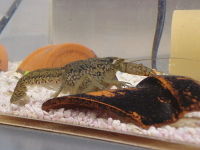Marbled Crayfish (Procambarus sp. "Marmorkrebs")
From The Aquarium Wiki
Procambarus sp. "Marmorkrebs"
19 Litres (5 US G.)
2.5-10.2cm (1-4 ")
Freshwater
7 - 7
18 -25 °C (64.4-77°F)
6-6 °d
2-4 years
Contents
Alternative Names[edit]
- Marbled crayfish, Parthenogenetic Crayfish, Procambarus fallax f. virginalis, "Procambarus marmorkrebs" (sic).
- Marmorkrebs are closely related to Procambarus fallax. A scientific paper (Martin et al. 2010[1]) suggests marbled crayfish be considered an asexual "form" of P. fallax. This is slightly problematic, as "forms" are not often used in scientific names for animals, although the practice is common in plant names.
- Marmorkrebs is suggested as a common name because it is distinctive and less likely to be confused with other crayfish with marbled colouration.
Sexing[edit]
- All marbled crayfish are female and reproduce via parthenogenesis. In related species, males have distinctly different anterior swimmerets than posterior; in females, all swimmerets are very similar.
Tank Compatibility[edit]
- Larger fish may eat smaller baby crayfish. These crayfish are best in species tanks as they pose a threat to bottom dwelling fish or fish that rest on the substrate during the night. They may also attack other invertebrates.
Diet[edit]
- Marmorkrebs accept a wide range of food, but may have a slight preference for plant materials. They will eat sleeping or dying fish, dead fish, and meaty sinking pellets designed for crabs or Cichlids. They will also eat softer plants if they are still hungry.
Feeding Regime[edit]
- Feed twice per day. If pellets get mouldy, remove them. If you see mysterious chew marks on your plastic plants or sponge filters (both have happened to me), then your crayfish are starving. Double the number of times you are feeding them or double the amount for each time, but not both.
Environment Specifics[edit]
- Provide at least one hiding place for each animal, with 1-2 extra hiding places. They will need these hiding places when they moult, or other crayfish may eat them. A long skinny pot, or length of 1 inch PVC tube (with one end closed) works fine. Crayfish feel safe in very tight space. These creatures are nocturnal and will eat sleeping fish.
- Marmorkrebs fare best at room temperature (about 20°C). Although they will grow faster in warmer water, they are also more likely to die.
Behaviour[edit]
- They tend to dig up rooted plants, but do not use floating plants either, as they will use them to escape the tank. Seal tank thoroughly as they are good climbers and will escape and die. Weight down the top so the crayfish will not push it open. Lower water level 2 inches below black strip at top of aquarium.
- Marmorkrebs are often quite mobile and visible around tanks during the day, unless they go into berry. When in berry, they rarely move or feed.
Identification[edit]
- Brownish appearance with darker brown mottling. Their colour can change depending on diet, occasionally showing slight blues or greens. Many species of Procambarus are extremely similar and difficult to distinguish based on body shape.
Species Note[edit]
- This species is illegal to buy and keep in the UK as it poses a risk to native invertebrates if it was to get into the wild. It is a carrier of a fungal infection known as "crayfish plague" which can kill the UK's only native Crayfish.[2]
- Marmorkrebs are a prohibited species in Missouri.[3] Some American states also have laws concerning the import and keeping of crayfish, including Arizona, California, Minnesota, and Utah.
Pictures[edit]
References[edit]
- ↑ Martin P, Dorn N, Kawai T, van der Heiden C, Scholtz G. 2010. The enigmatic Marmorkrebs (marbled crayfish) is the parthenogenetic form of Procambarus fallax (Hagen, 1870). Contributions to Zoology 79(3): 107-118. http://dpc.uba.uva.nl/ctz/vol79/nr03/art03
- ↑ Practical Fishkeeping Illegal Marbled crayfish poses threat to UK, Matt Clarke: 4.7.2007
- ↑ Conservation Action Meeting of the March 2010 Conservation Commission
